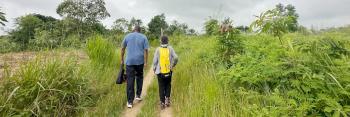Anthropological point of view by Dr. Patience Kabamba on the mission of Mbanza Ngungu - February 2023

Excerpts from the article Written by Pr. Patience Kabamba - Anthropology, African Studies, Philosophy
Professor of Anthropology at UPN (DRC) - Independent Researcher and Consultant
" At the beginning of this week, I was with a team of geologists in Mbanza Ngungu, in Congo Centrale. It was my first time to associate myself with these scientists whose object of study is to understand the life of the rock, its evolution over time and the underground hydraulic networks that form there and the resurgences following this presence of groundwater (groundwater that becomes visible sources). In our country, students are trained to become geologists (earth specialists), hydraulic geologists (who deal with underground hydraulic networks) and geomorphologists (those who deal with the shape the earth takes) . I spent time at the beginning of this week with the rock specialists and we visited two caves out of a hundred in the region.... The team of international researchers continued to work in other caves in the region when I returned to Kinshasa for teachings.
As I said at the beginning, the region we visited is made up of sedimentary rock that extends to neighboring Congo-Brazzaville, as is the case of the Mayombe forest that reaches Pointe Noire. This whole region contains a good hundred caves according to the specialist who led the team. The expression, “life is full of rocks” can be understood both literally and figuratively. It can mean that life is full of obstacles or hard bits to swallow. But, in this MDW, this expression is taken literally. There are plenty of caves in the Mbanza Ngungu area. If our expert counted a hundred, no doubt that an exhaustive study of the region could find more. The caves are part of the environment of the people who live in the nearby villages. Some are frequented and others not or rarely by the people of the village. I will come back to this aspect of two different ways of understanding the cave: one called “scientific” and the other called “mythical” or “mystical”.
For the moment, I would like to dwell on the second part of the title of this MDW: “the rocks are full of life”. Before this visit to the caves with geologists, if someone had told me that a rock was alive, if someone had told me about the biology of the rock, I was going to remain septical. But, inside the cave, I could see with my own eyes the life of a rock. The interior of the cave revealed its secrets with the appearance of the stalactites, these pieces of rock which hang like the lampposts which give its beauty to the cave or even the stalagmites which seem to grow from the bottom upwards like plants from above. the search for the sun's rays. The vertical encounter of a stalactite and a stalagmite is simply sublimely beautiful, like two lovers who reach the point of no return symbolized by an immortal kiss. The two caves I visited are exceptionally beautiful. The underground boulevard they open and all the decorations illuminated by sulfur or other elements stuck to the rock give them an irresistible majesty. This natural art inside the cave is undoubtedly, like all art, the great medicine that heals our existential tears. And besides, the inhabitants the village have understood this and do not hesitate to bring their patients or people with an incurable disease for modern medicine. In art as in religion, there is the chained man who wants to break loose. This is what explains the frequentation of this symbolic place par excellence which seems to link the finite and the infinite. The Africans who frequent these caves understand that they are the very presence of the infinite which comes to titillate the finite. This is the fundamental definition of aesthetics. For the Greeks, in fact, man is an imperfect God and God is a perfect man.
Before advancing in the mystical perception of the cave by most of the inhabitants of the surrounding villages, I would like to continue a little bit on the understanding that science gives us on the life of the cave. The formation of stalactites and stalagmites is simply due to the presence of water. For humans as for rocks, water is part of the elements that carry life; without water, there would be no life for the rocks or for the plants; without water, there would be no life for men or animals. Water is life, they say. If the rocks spoke our language, they were going to confirm it.
The earth as we know it is not a calm, quiet and peaceful environment. It is subject to the hyperactive bubbling of the interior. Seismologists know a lot about it and the earthquake of magnitude 7.8 on the Richter scale which struck Syria and Turkey has just reminded us of this brutally by claiming nearly 41,000 human lives.
The rock resists underground tremors but it undergoes cracks over time. The water enters these cracks and over time, a long time, the soluble parts of the rock will give way and this will give rise to stalactites and stalagmites which will attach, like a branch to the trunk of a tree, to the insoluble part of the rock. This is what explains the morphology of the cave and its quasi-architectural internal “decorations”. Water is therefore the basis of rock life. Geological studies can give us information on the climate, on the longevity of the rock and with this information the scientist can risk making a predictive projection on the changes to come, and sometimes the precautions to be taken.
The cave remains a mysterious place for the inhabitants. It is not an object of study as it is for the geologists I accompanied. The cave is part of their nature and therefore of their being. There is no objectification of nature in African culture. We are nature and nature is us. The caves are therefore perceived as places where one can communicate with the ancestors, places where one will speak to the invisible and infinite always at the gates of the finite. It is the place where the imperfect God that is man will dialogue with the perfect man that is God.
The two ways of apprehending nature are different, Period. None is superior to the other. The guide who makes incantations in front of the cave and the scientist who studies the composition of the cave exhibit two distinct ways of experiencing the reality of the cave. Neither way is superior to the other. They are simply different. It is exactly like evolutionism and creationism, two distinct cognitive attitudes. Period.
I take this opportunity to thank my friend and colleague, Professor Roland Kakule, who introduced me to this world, and the two experts from Belgium, Pascale Lahogue and Imen Arfaoui, not to mention our future geologists, Nadège Ngala and Junior Lutete, and our guides and our driver."
